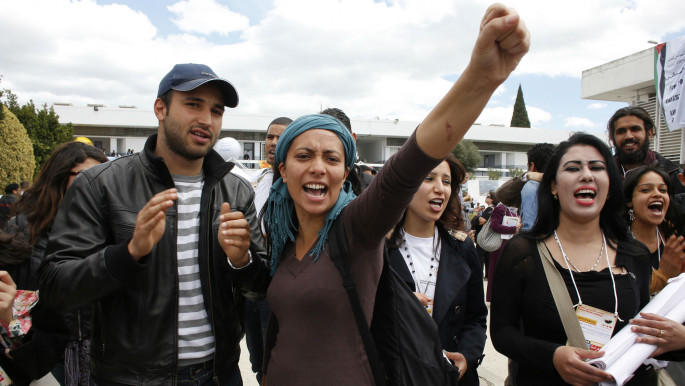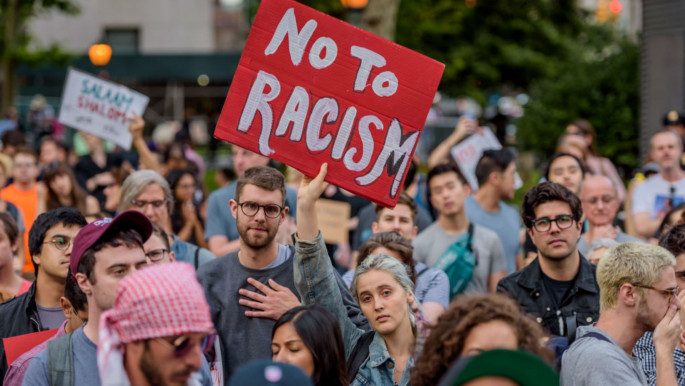
Jack Ryan is The Good Guy with the Gun
Set in the present day, the show relies on Arab narratives adjacent to terror, while transforming Office heartthrob John Krasinski into a sleek, patriotic hunk.
The casting directors employ minimal diligence; acclaimed Arabs were hired to play Arabs. They speak in Arabic, not gibberish. The character development and plotlines that follow, though, fully deny agency and depth to the many Arab characters.
Jack Ryan jets between Washington DC, France, and blended depictions of Yemen and Syria. Jack is a charming, reluctant analyst on the CIA's overseas financing team, a troubled war hero and genius whose eye for terror finance networks leads him to become the chief Good Guy with the Gun.
The show's imagination is bound by orientalist traditions dating back a century in Hollywood, framing the West and Arabs in existentially opposed narratives, branding American foreign policy as a dignified saviour.
 |
|
| Read also: 'The Other': how the US media demonise Arabs |
In early episodes of Jack Ryan, viewers are acquainted with Ryan's redemptive and likeable qualities. He unearths financial patterns for terrorist cells in Syria and Yemen, and is initially doubted because of his junior role. However when he warns of "another 9/11", earnestly stating that "9/11 only cost half a million dollars", he is heard and respected.
Jack Ryan's instincts are all correct and his inability to be morally wrong echoes the "Us vs. Them" narrative in the unending War on Terror. In the pilot episode, a CIA helicopter swoops the unsuspecting analyst away from the verge of romance, parachuting him to a terror cell in Yemen to question dirtied, scruffy terrorists. Jack is clean shaven, as always.
Ali and Suleiman, the main antagonists, are the most developed Arab characters. It's a low bar – in one scene they bid farewell using a phrase unheard in Arabic, likely concocted in a homogenous writer's room. In a scene at the port in Aden, Yemen, Ali serenely doodles until he remembers the warplanes that killed his family; the source of his insurmountable bloodthirst. Ali eventually sets off to Paris, solo aboard a Yemeni fishing boat, mystically reaching his destination, predisposed for terror nonetheless.
Throughout the first season, Ali and Suleiman flirt with morality, but are nevertheless drawn into violent extremism, with no regret, only an unflinching desire for vengeance.
 |
Arab characters are soundtracked by suspense and come off as adverse to romance, a jarring pattern to observe as Jack Ryan freely pursues his cinderella |  |
In the second episode, Jack Ryan teams up with the French police chief to track down Ali in Paris. The chief is painted as empathetic, even a fierce defender of Muslims in France. When Ali kills her, Jack is disappointed that Ali's university degree could not avert his attraction to terror. Jack is the Good Guy with the Gun once more, killing Ali.
 |
|
| Read also: Living with a torn identity: Being an immigrant in Trump's America |
Suleiman's wife, Hanin, represents a Muslim Woman in Need of Salvation. Hanin's backstory is equally void of depth and context – we learn that she forcefully married Suleiman at 16 and has been a submissive wife ever since. After escaping her husband's band of terrorists, their young son Samir remains loyal to the father, insinuating a gendered inevitability into indoctrination.
Hanin's eventual rescue comes from an American drone operator acting against authority – he kills a terrorist who is attempting to rape her in a nameless village. Laura Bush's 2001 "War on Women" speech on Afghanistan acts as a convenient backdrop to this disturbing scene.
Arab characters are soundtracked by suspense and come off as adverse to romance, a jarring pattern to observe as Jack Ryan freely pursues his cinderella. His romance is cheeky and celebrated, orchestrated with purpose and emotion, because a hero like Jack Ryan deserves Cathy Mueller. After all, she cured ebola, while he crushes another parasite.
Much of the dialogue between the American or French characters is boilerplate language, alluding to resisting stereotype and critiquing imperialism, eventually reverting to a binary narrative of good and evil.
In one scene, a colleague tells Jack: "What motivates them is the same thing that motivates them all," and Jack quips: "There's something different about his agenda… more calculated, look at the way he collected money, it's sophisticated. Like Bin Laden." An old enemy familiarises viewers with a new one, with only a layer of eyeliner distinguishing the villains.
The tropes in Jack Ryan are not fresh – they embody Hollywood's history of demonising Arabs and Muslims. Media scholar Jack Shaheen wrote The TV Arab in 1984 interviewing TV executives in Hollywood on the topic and in 2001, he produced Reel Bad Arabs, a follow-up documentary. In it, he reviewed a thousand films from between 1896 and 2000 portraying Arabs and Muslims, and concluded that a dozen were positive depictions, 52 were neutral, and more than 900 were negative.
 |
He reviewed a thousand films from between 1896 and 2000 portraying Arabs and Muslims, and concluded that a dozen were positive depictions, 52 were neutral, and more than 900 were negative |  |
Pop Culture Collaborative Senior Fellow Dr Maytha Alhassen has deepened the socio-political analysis, producing Haqq and Hollywood: Illuminating 100 years of Muslim Tropes And How to Transform Them, a critical report with a hopeful outlook, highlighting positive examples of representation in the last few years.
I picked up The TV Arab from my grandparents' bookshelf in Beirut grasping that, as older Syrians, they've absorbed the ramifications of being portrayed as barbarians across the pond.
Jack Ryan highlights the moving target of inclusive TV representation for Arabs. This frustration was crystal clear in 2013, when Homeland hired Arab graffiti artists to depict a Syrian refugee camp and the artists wrote "Homeland is racist" in Arabic.
Read more here: 'Homeland is racist' reads graffiti in hit TV show
The argument extends to so many of this decade's blockbusters set in the Middle East. It's a tired conversation because the societal implications are clear; hate crimes against Arabs and Muslims are on the rise, war with Iran is on the tip of John Bolton's whiskers, and the normalisation of these images empowers a president who has instituted a Muslim Ban, "to figure out what the hell is going on."
The process of understanding that these images are half-baked and hurtful is one that requires introspection and a rejection of imperial narratives. In the US, three highly publicised incidents of blackface have emerged in the last month. White America has not confronted it's own specter of ideology and racial violence, a legacy illustrated and bolstered by caricature time and time again.
Similar to blackface, advancing barbaric depictions of the TV Arab require an American audience who enjoy the experience – while minimising the pain and concerns of those who, backed by history, say otherwise.
What's ironic is that Middle Eastern actors are victims of an exclusionary narrative, one telling Americans that terrorist groups in the Middle East are uniquely an American enemy. The uncritical acceptance of a show like Jack Ryan tells us that Hollywood is unprepared to engage with multi-dimensional Arab stories, while many Americans still entertain the twisted fantasy of being the Good Guy with the Gun.
Azmi Haroun is a Syrian-American writer and activist studying at Columbia Journalism School.
Follow him on Twitter: @asmuchazmi
Opinions expressed in this article remain those of the author and do not necessarily represent those of The New Arab, its editorial board or staff.





 Follow the Middle East's top stories in English at The New Arab on Google News
Follow the Middle East's top stories in English at The New Arab on Google News


